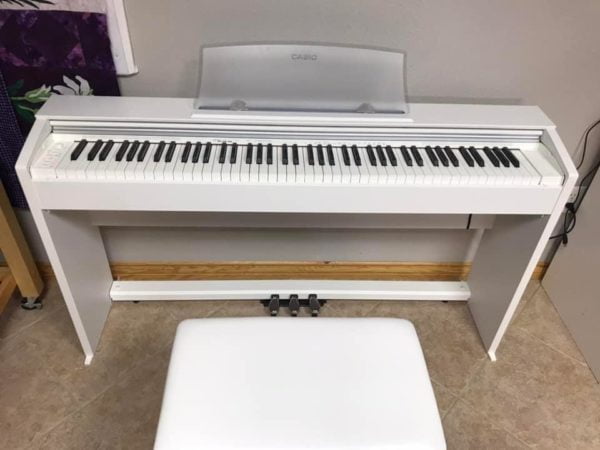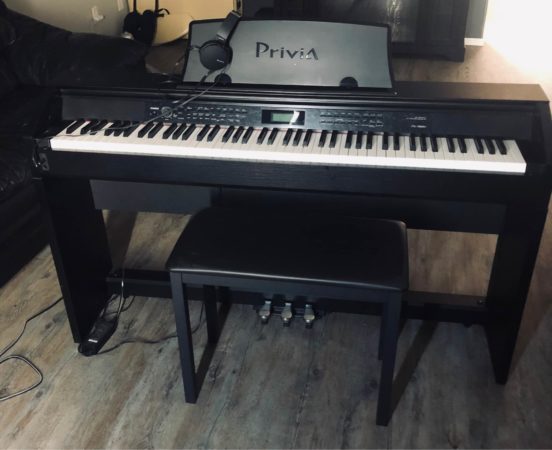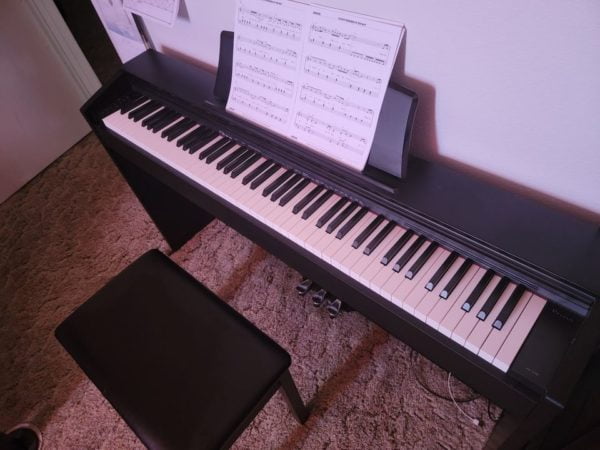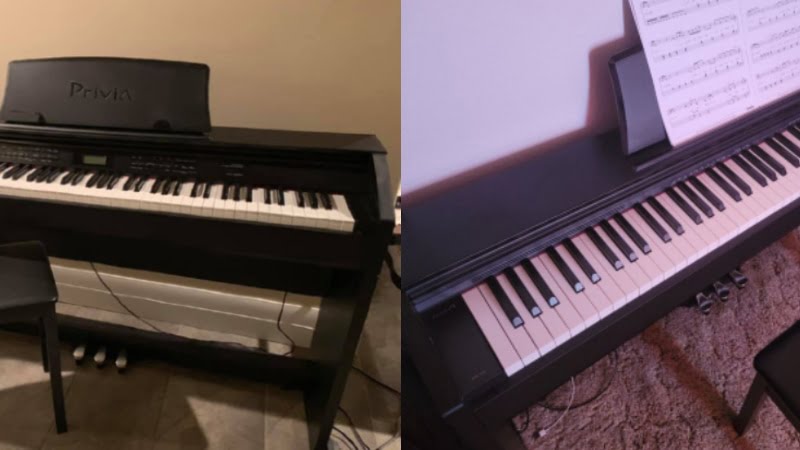Learn all the differences between these two models and which one is the better option in this Casio PX-770 vs 780 review.
Choosing a winner in this Casio PX-770 vs 780 comparison was pretty tough, but in the end I had to choose the PX-780, solely because of its varied sound library and more sophisticated features.
With that said, I’m still on the fence when it comes to the price difference between these two models. In my research, I found that the PX-780 didn’t have that many extra features when compared to the significantly cheaper PX-770.
So, if you’re a beginner on a budget, the Casio PX-770 offers a great set of features at a much lower price than the Casio PX-780.
But with a sound library of 240 different voices and a great sequencer feature, the Casio PX-780 definitely offers more versatility. If you’re a more advanced pianist or a student looking to invest in a model with more features, the Casio PX-780 is a great option, but keep in mind that it’s only slightly better than the PX-770, which is over $100 cheaper.
Casio PX-770 vs 780: Comparison Chart




Last update on 2025-12-21 / Affiliate links / Images from Amazon Product Advertising API
Casio PX-770 vs 780: The Features
Since these two pianos are from the same brand and product line, it was really fun to compare the different features. And despite being the more expensive option, the Casio PX-780 was the definitive winner in only one category: tone. In terms of the other categories, the PX-780 was actually tied with the PX-770, with the final score being 3-2, in favor of the PX-780.
So, despite the price difference, the PX-780 only won by one point. While that still makes it the better option, it also makes the PX-770 worth considering if you’re looking to save money and still access a bunch of cool features.
Feel
The winner: Tie
Arguably the most important feature of any digital piano is the feel, or how closely it resembles an acoustic piano. And in this regard, both the PX-770 and the PX-780 offer the same feel. In fact, when testing out these options myself, I could barely tell the difference between the two.
+Hammer Action
Both of these pianos come with scaled hammer action, which is largely considered the gold standard for digital pianos. If you’re looking for a quality digital piano, at the very least, it should feature some form of scaled hammer action.
With scaled hammer action pianos, the keys on the left side are heavier than the ones on the right, which is similar to how an acoustic piano feels. That way, you get a more realistic feel on the digital piano which will make it much easier for you to switch between acoustic and digital options.
When learning the piano for the first time, it will help you out a lot if you have an instrument with scaled hammer action. While it might be heavy on your fingers and it will take some time to adjust to the weight, it is well worth it in the end.
On top of that, both pianos have adjustable touch response, so you can always tweak the settings if you have lighter or heavier hands than usual.

+Key Texture
Another cool feature of both of these pianos are the textured keys. Of course, it would have been nice if either of these pianos featured real wooden keys, but that would have bumped up the price significantly. With that said, since the PX-780 is the more expensive option, it would have been nice to see real wooden keys.
However, even if these pianos have plastic keys, Casio went out of their way to ensure that they still featured realistic key texture. To do this, they coated each of the keys with a special coating to simulate the texture of ebony and ivory.
Granted, there is still a noticeable difference between these plastic keys and real wooden keys. However, it is much less noticeable than on digital pianos with glossy plastic keys.
Tone
The winner: Casio PX-780
While both of these pianos use the same tone generator, the Casio PX-780 features a much wider sound library than the PX-770. In terms of quality, both pianos offer fairly similar tones, but since the Casio PX-770 only features 19 voices while the PX-780 comes with 240 voices, the Casio PX-780 won out in this comparison.
+Tone Generator
One advantage of choosing either of these pianos are the tones. Since these pianos run on the Casio AiR Sound Source, all the voices are of the highest quality, especially the piano voices.
The AiR Sound Source is a processor designed to give off more realistic and bright piano voices. So, when playing either of these options, you can expect a very realistic tone that is similar to real acoustic pianos. And for their price, I have to admit these tones exceeded my expectations.
And while I noticed that the quality of the voices was almost the same, I have to admit that the voices sounded a bit better on the PX-780. With that said, that doesn’t necessarily mean the PX-780 has a better tone generator.
Instead, I figured that the higher sound quality actually came from the speakers, since the PX-780 features higher quality speakers than the PX-770.
+Sound Library
The PX-780 features a very slight advantage when it comes down to tone quality. But the real reason I declared it the winner in this comparison is it’s incredibly versatile sound library.
Most digital pianos only come with a handful of tones, since manufacturers focus on quality over quantity with digital pianos. This is why the Casio PX-770 only features 19 different voices. While this is a fairly limited selection, you can rest assured that each and every voice on the PX-770 is top-quality.
However, keep in mind that the Casio PX-780 features 240 different voices. These range from acoustic and electric piano tones to synths, bass, organ, and even some more abstract voices such as drums and SFX!
On top of that, the quality of the voices on the PX-780 is a bit better than the PX-770 because of its speaker system. So, if you’re looking for a versatile piano with a multitude of different voices, the PX-780 is the clear-cut winner.
Piano Features

The winner: Tie
I honestly expected that the PX-780 would easily win out when it came to piano features. But since it only really features one extra playing mode while having the same effects and polyphony as the PX-770, the pianos were tied in this regard.
This isn’t a knock on the PX-780’s quality but more a testament to the PX-770’s quality. Despite being the cheaper option, the PX-770 was able to provide the same piano features of the PX-780, which is one of the reasons it’s a favorite among many different piano students.
+Playing Modes
These pianos don’t come with a wide array of playing modes. In fact, aside from the standard playing mode, the only additional mode is lesson or duet mode. With this mode, you can divide the piano into two “mini-keyboards” with the exact same pitch and timbre.
This mode is designed to make it easier for teachers and students to go through lessons. When you activate this mode, the teacher and student can play side by side, producing the same sounds without having to cross over.
Both pianos also feature a recording mode, but the PX-780 admittedly has a better recording function. While the PX-770 can support up to two-track MIDI recording, the PX-780 features a 17-track sequencer.
Now, if you’re a beginner or even a recording musician, you won’t be using all 17 tracks on the sequencer since there are many different recording options using computers that offer even more versatility. With that said, the sequencer is still a nice feature to have some musicians.
+Polyphony
Both pianos feature the same polyphony, with a 128-note maximum. This is enough to handle most piano pieces and is considered the ideal polyphony for any pianist. Again, since the PX-780 is more expensive, it would have been nice to see 256-note polyphony, but sadly this feature isn’t present.

Casio PX-770 vs 780: The Similarities
As two digital console pianos by the same brand, these models feature a lot of similarities. For example, they have the same tone generator and hammer action system, which are both considered top-quality in the piano community.
Additionally, they come with a similar set of effects. On both pianos, you can apply chorus, brilliance, and reverb effects. As a beginner, you probably don’t want to distract yourself with all these effects, but it admittedly gives you more control over your tone. On top of that, it also gives you a lot of room for experimentation.
Quick Rundown of the Casio PX-770
- IMMERSIVE GRAND PIANO SOUND – Award-winning AiR Sound Source with stereo grand piano, damper resonance, and 19 tones for rich, expressive performances.
- REALISTIC TOUCH & FEEL – 88-key Tri-Sensor II Hammer Action with ebony/ivory-feel keys, adjustable touch sensitivity, and hammer response.
- CLEAR, POWERFUL AUDIO – Built-in stereo speaker system delivers detailed, balanced sound across the full range.
- BUILT FOR LEARNING – Duet Mode, dual headphone jacks, 60 built-in songs, MIDI recorder, and Concert Play orchestral backing tracks.
- SLIM, STYLISH DESIGN – Elegant cabinet with sliding key cover fits any décor. USB-MIDI port connects easily to Mac, PC, iOS, or Android—no drivers needed.
Last update on 2025-12-21 / Affiliate links / Images from Amazon Product Advertising API
Quick Rundown of the Casio PX-780
- 88 Note Scaled Hammer-Action Keyboard
- AiR Sound Source
- Ebony and Ivory Feel Keys
- Hammer Response and String Resonance Simulation
Last update on 2025-12-21 / Affiliate links / Images from Amazon Product Advertising API
Product Videos
References
- Casio PX-770: https://www.sweetwater.com/store/detail/PX770BK–casio-privia-px-770-black-finish
- Casio PX-780: https://www.sweetwater.com/store/detail/PX780BK–casio-privia-px-780-digital-home-piano
Lulacruza is an electronic folk duo operating at the junction of the hypermodern and the ancient. Our music weaves together hypnotic female singing, South American folk instruments and electronic processing, while channeling pulsating waves from the source of creation.
Lalucruza is also a community where you can connect with other music lovers to collaborate, exchange ideas and share knowledge. A platform for who wants to learns the basics of playing piano, guitar, drum masters’ technique, etc.. is the premise of our website.
